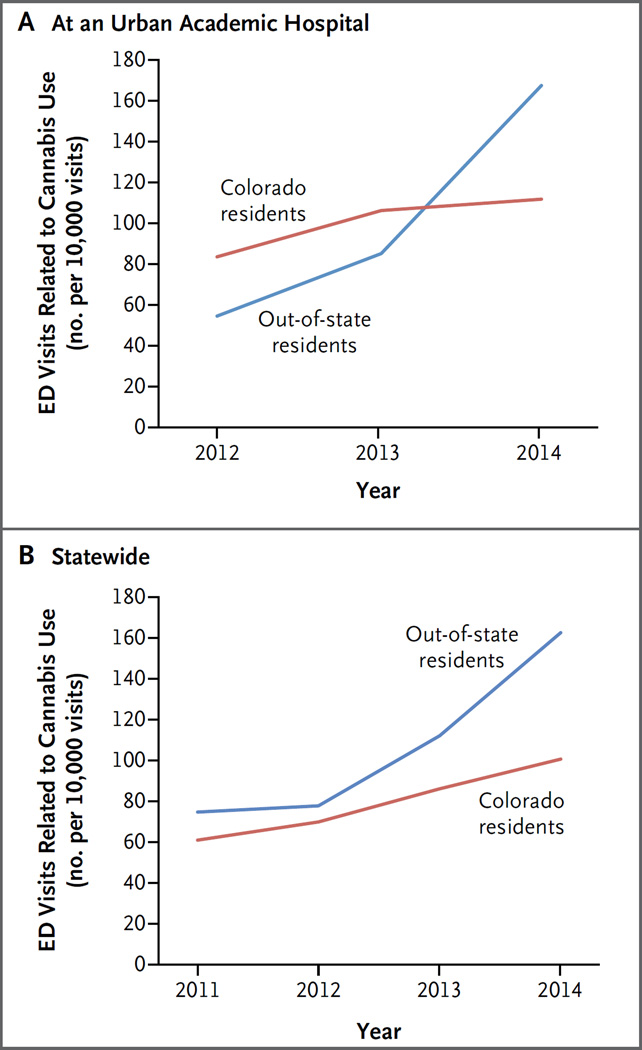To the Editor
The liberalization of marijuana policy in Colorado was a stepwise process; voters approved the legalization of medical marijuana in 2000, medical licensure and use increased in 2009, voters approved the legalization of retail marijuana in 2012, and retail sales began in 2014. Given the reports of marijuana tourism (i.e., visits to the state with the purpose of marijuana product consumption),1 we sought to determine whether the rates of emergency department (ED) visits possibly related to cannabis use have increased disproportionately among out-of-state residents, as compared with Colorado residents.
We conducted a cross-sectional study in the setting of an urban academic hospital in Aurora, Colorado, that has approximately 100,000 ED visits per year and compared the rates of ED visits with International Classification of Diseases, Ninth Revision (ICD-9), codes of cannabis use between out-of-state residents and Colorado residents from 2012 through 2014. Residency was determined by the ZIP Codes given by the patients when they registered in the ED. The rates of visits with ICD-9 codes for cannabis use were adjusted for the volume of annual visits, and consecutive years were compared with the use of the two-sample z-test of proportions. We confirmed our findings with the use of data from more than 100 hospitals reported to the Colorado Hospital Association from 2011 through 2014.
At our institution, the rate of ED visits possibly related to cannabis use among out-of-state residents doubled from 85 per 10,000 visits in 2013 to 168 per 10,000 visits in 2014, which was the first year of retail marijuana sales (rate ratio, 1.98; P = 0.001). Among Colorado residents, the rate of ED visits possibly related to cannabis use did not change significantly between 2013 and 2014 (106 per 10,000 visits in 2013 and 112 per 10,000 visits in 2014; rate ratio, 1.05; P = 0.26). The rates did not change significantly between 2012 and 2013 among out-of-state residents or Colorado residents. Clinical and demographic data are provided in the Supplementary Appendix, available with the full text of this letter at NEJM.org.
The data from the Colorado Hospital Association did not show a significant change from 2011 to 2012 in the rate of ED visits with ICD-9 codes of cannabis use among out-of-state residents; however, from 2012 to 2014, the statewide rate among out-of-state residents rose from 78 per 10,000 visits in 2012 to 112 per 10,000 visits in 2013 to 163 per 10,000 visits in 2014 (rate ratios, 1.44 [2012 to 2013] and 1.46 [2013 to 2014]; P<0.001 for both comparisons). Among Colorado residents, from 2011 to 2014, the rate of ED visits possibly related to cannabis use increased from 61 to 70 to 86 to 101, respectively, per 10,000 visits (rate ratios, 1.14 [2011 to 2012], 1.24 [2012 to 2013], and 1.17 [2013 to 2014]; P<0.001 for all comparisons).
The flattening of the rates of ED visits possibly related to cannabis use among Colorado residents in an urban hospital (Fig. 1A) may represent a learning curve during the period when marijuana was potentially available to Colorado residents for medical use (medical marijuana period) but was largely inaccessible to out-of-state residents.2 It is possible that reporting bias in the era after legalization has confounded these findings; however, we previously found that the reporting on marijuana use among Colorado residents during the medical marijuana period was reliable.3
Figure 1. Emergency Department (ED) Visits Possibly Related to Cannabis Use at an Urban Academic Hospital in Aurora, Colorado, and Statewide.
Statewide data were obtained from the Colorado Hospital Association.
ED visits related to cannabis use appear to be increasing more rapidly among out-of-state residents than among Colorado residents (Fig. 1). The initial educational efforts through mass media have focused primarily on Colorado residents. These data underscore the importance of point-of-sale education for visitors regarding the safe and appropriate use of marijuana products.
Supplementary Material
Footnotes
The views expressed in this letter are those of the authors and do not necessarily represent the views of the Agency for Healthcare Research and Quality or the National Institutes of Health.
Disclosure forms provided by the authors are available with the full text of this letter at NEJM.org.
Contributor Information
Howard S. Kim, Northwestern University Feinberg School of Medicine, Chicago, IL
Katelyn E. Hall, Colorado Department of Public Health and Environment, Denver, CO
Emma K. Genco, University of Colorado School of Medicine, Aurora, CO
Mike Van Dyke, Colorado Department of Public Health and Environment, Denver, CO
Elizabeth Barker, Colorado Department of Public Health and Environment, Denver, CO
Andrew A. Monte, Email: andrew.monte@ucdenver.edu, University of Colorado School of Medicine, Aurora, CO.
References
- 1.Smith A. Tourists flock to Colorado to smoke legal weed. CNN Money. 2014 Aug;22 ( http://money.cnn.com/2014/08/22/smallbusiness/marijuana-tourism-colorado/) [Google Scholar]
- 2.Monte AA, Zane RD, Heard KJ. The implications of marijuana legalization in Colorado. JAMA. 2015;313:241–242. doi: 10.1001/jama.2014.17057. [DOI] [PMC free article] [PubMed] [Google Scholar]
- 3.Monte AA, Heard KJ, Hoppe JA, Vasiliou V, Gonzalez FJ. The accuracy of self-reported drug ingestion histories in emergency department patients. J Clin Pharmacol. 2015;55:33–38. doi: 10.1002/jcph.368. [DOI] [PMC free article] [PubMed] [Google Scholar]
Associated Data
This section collects any data citations, data availability statements, or supplementary materials included in this article.



